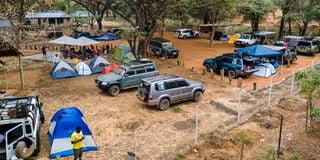Wanderlust groups inspire Kenyans to discover ‘hidden’ travel destinations

Motorists who make up part of the group Bundu Rovers, an offroad enthusiasts' travel group that share their adventures on social media in order as they go to remote and least explored parts of Kenya, camping at a remote school.
What you need to know:
- Planning a hike or tour has never been an easy task but travel groups and social media are adding to the allure
- The gear they require is also more rigid and warm attire is also encouraged for the sometimes wet and cold temperatures of these areas.
- The treks usually start from mid-morning into the night and then go into activities which include bonfires.
When you go on social media and key in #TembeaKenya (travel around Kenya), you will come across a gallery of photographs, videos and stories of people who visited different parts of the country and captured their experiences in unique ways.
Not wanting to be left out, and seeking to document the ‘hidden’ destinations they have visited, many Kenyans are increasingly posting their travel stories.
Long gone are the days when all roads almost exclusively led to the sights and sounds of Mombasa, Nakuru, Naivasha or Kisumu for holiday destinations.
Such is the obsession to discover stops in Kenya that do not usually receive many visitors that packages are coming up on social media to cater for even the most modest of budgets.
Forests, savannahs, waterfalls, ravines, dunes, caves and other places across Kenya.
Ricky Aguda is an agricultural consultant who trains farmers.
This was the direct link between him and Land Rovers. He has had to go through roads that are in some hard-to-reach places for work.
In 2008, he struck a rapport with other Land Rover owners who were servicing their vehicles in the same garage. They soon included other like-minded people and, in 2009, set up a club for “trips to the bush”.
“Initially it was the Land Rover, predominantly the Defender. Over time, because of the interest of others who owned 4x4s and wanted to take them off the tarmac, we opened up and had them join for a year. Those who found it was a bit too much would drop off. Back then, the roads were really bad. When it rained, you would easily slip off and break down in the middle of nowhere,” says Ricky.
Nowadays, with the road networks much better, the group mostly revolves around finding interesting destinations off the beaten track.
The biggest challenge in getting a membership is trying to convince car owners that their nice and expensive 4x4s are not just for avoiding potholes in urban roads. And social media has had an impact unimaginable a decade ago.
“People think holidaying is going to Mombasa or a quick dash to Naivasha. Sometimes, they’ll party in Nakuru or even go to Kisumu. But the sites remain the same. All of a sudden, when we posted our rides, first through our website and now on social media, people started asking if we were really in Kenya,” says Ricky.
“Instagram is a visual platform, so we needed to join to show people that you are in a beautiful country. You don’t need to go to Dubai to have an experience of a lifetime, just go to Loiyangalani and put your feet into Lake Turkana.”
The club has since grown immensely, now having more than 33,000 followers across Facebook and Instagram.
Other fun activities they have during the trips include car challenges like tug of war or mud rides.
Being made up of mostly professionals with full-time jobs or businesses, they have to plan well for their four annual trips. The first one is in March, during the long rains. The second is slated for June, around Madaraka Day.
The third trip is in August, traditionally around the school break in order to involve the whole family. Then there is the last in early December.
“But in between, we have lots of meetings. We have spanner days, where we go through mechanical stuff on the vehicles. We also have social nights to get to know each other, and also quick weekend trips or short trips to check out quick new routes,” adds Ricky.
The group currently has about 80 members and on average, every weekend, there are about 10 to 15 members out travelling. Hence, it would seem that they are constantly on the road but that isn’t the case.
Members pay a joining and annual fee of Sh20,000. They are then provided with memorabilia like aprons or bush kits, and evacuation insurance cover for the East African region. The fee is also used for administrative costs.
Depending on the destination, the trips typically involve camping with the travellers’ own food and gear to cut down on accommodation costs.
The other expenses are out of pocket, but the experience is made even better when they bring together the different meals they each prepare at the cookouts.
Fuel is the most common and highest cost when it comes to trips. They try to drive no more than five hours a day and the trips begin at 7am at a meeting point, where basics like tyre pressure are checked.
One interesting adventure the group points out was a Turkana County trip. They went through Kerio Valley and camped at a school along the way after getting permission at 4 pm.
They selected a spot, had a quick shower in the mobile bathrooms and then made their meals.
At around 7 pm, they had a bonfire, the new members introduced themselves and they all shared their experiences, especially humorous stories about cars breaking down, “We don’t really have this recognition of social class in our group.
We don’t want you to introduce yourself as a top banker or tell us about your last trip to Mauritius.
A typical introduction would be your name and what you drive, and maybe people making fun of the stereotypes about your vehicle brand.
For example, Toyota drivers are told they like to brag about how their cars are reliable, while Land Rover guys are made fun of for taking their flatbeds with them everywhere,” says Ricky.
Such conversations are just a way for them to get away from the usual stress of life, but they also get to enquire from each other about camping gear, cooking units or even car accessories, before calling it a night at midnight in preparation for the next day’s drive.
They are also involved in corporate social responsibility while on their trips by distributing foodstuffs, books and other materials through religious organisations in those areas.
They also partner exclusively with organisations that help children who suffer from neurological disorders, and fistula, due to the stigma associated with these.
“When you go out there in the middle of nowhere, you can imagine how much harder it is for these communities to deal with these situations,” says Ricky, adding that their social media presence also increases visibility for the causes.
The group previously had an on-and-off partnership with KCB and Kenya Forest Services where they planted trees across the stretch of the highway along Kinale Forest and Meru.
They also helped put up a fence to keep elephants away from a community in Meru.
If you’re not into 4X4s and like to have an active life even while on vacation then Baiskeli Adventures would be a good fit.
The group takes people on cycling adventures across the country. They also include hiking, camping and rock climbing sometimes.
Rakesh Young, the founder and CEO of this Nairobi-based outfit, studied tourism management but his first internship saw him working at a bicycle shop.
“I went into campus knowing I wasn’t going to do the typical wildlife or beach holiday safaris — I didn’t know what kind of tour at the time. During my second year, my lecturer led me to what she thought was a bike safari company but it ended up being just a bike shop,” he says.
Even though he hated going to repair bicycles, he went on every day of his internship, and they were soon given bicycles by the shop instead of transport allowance.
He loved cycling and combined it with his passion. After much research, he started holding bike tours to Nairobi’s Karura Forest in 2012. Two years later, he quit working at the bike shop and started Baiskeli Adventures.
“Cycling in Nairobi was in two categories then: commuter cyclists and competitive cyclists. There were no leisure or adventure cyclists. The weekend activity was to drive out to OlePolos (in Kajiado County) for nyama choma and drinks. I wanted to fill the gap in the active lifestyle market. Using Facebook at the time, the two of us would go on rides and shout about it,” says Rakesh.
He had found out that for everything fun and outdoors, social media was the best medium to communicate information, says Rakesh.
The thing about social media is it definitely influences the right people. From the first two, more people started joining and then it created a market for the bicycle shop to sell more wares. But then people started asking, “Where next?” Charging Sh200 per rider, they now started cycling to areas like Ngong Hills and Kiambu.
Nowadays, he charges up to Sh60,000 for multi-day trips and takes between 15 to 30 cycling enthusiasts twice a month.
“We’re big on selling an intimate experience. For multi-day trips, I take a maximum of 15 cyclists while single-day rides can accommodate up to 30 people. I am able to interact with everyone and make it fun. I work with people on a need basis like chefs, guides, drivers and medics when we travel,” says Rakesh.
They usually use an overland truck that picks the cyclists at a pick up point. A Landcruiser with a roof rack carries up to eight bicycles when they have smaller groups. Rakesh insists that he never puts his clients on the road; they ride primarily off-road.
The single-day trips can be classified into two. Within city limits, cyclists get to interact at a water point and snack area halfway into the ride and later on at lunch.
But when the rides are out of town, even if it’s one day, let’s say Hell’s Gate, at the end of the ride they’ll get to dip at the Geothermal Spa to get another relaxing experience post-ride. The single-day trips begin from Sh1,500.
A notable trip by Baiskeli Adventure was a multi-day cycling experience from Nanyuki to Moyale. They would wake up every morning before sunrise, have breakfast prepared by the chef and cycle 100 to 120 kilometres a day.
They had a vehicle trailing the riders in case someone needed assistance and there were also water and lunch points. Not many activities were done besides camping, except for when they crossed over into Ethiopia from Moyale for the coffee ceremony which was an experience to remember.
Another expedition saw them also island hopping in Lake Victoria, experiencing new things every day: early morning rides, evening hikes on Gembe Hills, boat rides, learning about the culture of the Wasamu clan from the Suba in Mfangano who are said to be rainmakers. They don’t exactly just stick to cycling.
Social media tools like reels — which are able to combine both photos and videos to summarise a whole trip into just a minute-long clip within seconds — have made it easier to share more visuals of their activities, mostly using their phones.
This attracts more people to join their subsequent adventures. The group also uses the reels to also introduce people to the other side of what it takes for a ride, like how they go about scouting locations.
With a following of more than 28,000 on Facebook and Instagram, Baiskeli Adventures is open to the public for whenever they have trips and there is no subscription fee.
If you just want to go off on a weekend trip with a group of adventurers and you don’t want to take your car or are not into cycling, Lets Drift will be the community for you.
Alex Kamau founded and leads this community and his story is not new to many. He founded it after graduating from his art and design studies and not being interested in going into the corporate world.
He took photography as a hobby and took photos of waterfalls, caves and forests. The photos he shared on Instagram grew the curiosity of his friends and the group grew from there.
He was just glad to have people accompany him and didn’t charge them. It was during the Covid-19 lockdown that the group really gained momentum, as people took to hiking as a pastime with social and religious places like churches and bars had been closed.
“Hikes and camp places were so expensive. When I started hiking, I wanted to have experiences that I could afford and for other people like me.
Instead of charging people per hike, we charge them per month. For Sh1,000, you can attend as many hikes as you can, which also gives you flexibility in case you get to hold up on a certain week of your subscribed month,” says Alex, adding that members pay for their own fare to the spots, which are usually an hour from the city.
Hikers meet near Hilton Hotel and walk to the stages of public transportation heading in their direction.
This means you can go on a hike between 8 am and 4 pm and start heading back to Nairobi.
You also carry your own snacks. Recently, however, they have been able to also organise hikes that they charge premium prices for and that includes camping to farther destinations.
The community has around 23,000 followers across social media currently.
Lets Drift's monthly calendar contains 25 to 30 hiking experiences, up to four hikes every Saturday and around three hikes every Sunday.
The difficulty of the hikes is graded into beginner, moderate and challenging hikes.
Members get to book themselves for whichever hike they feel most comfortable with on the community’s website.
At the locations, guides give the group a brief about the hike and then they stretch.
If they get to the locations early, then they take breakfast at the local businesses, sometimes having called beforehand to inform them they will be heading there. The hikes are between 10 to 55 kilometres, ending between 2 pm and 6 pm.
However, some prefer driving themselves to the spot and the organisers get them parking spots and also pin locations.
For the premium hikes, a private bus is hired and they usually go to destinations that are around three hours away from the city to places like Aberdares and Nyeri.
The gear they require is also more rigid and warm attire is also encouraged for the sometimes wet and cold temperatures of these areas.
The treks usually start from mid-morning into the night and then go into activities which include bonfires.
“We’ve even seen relationships blossom as new people get to interact on these trails,” says Alex of the community which has between 350 to 500 active members at any one time.
More than 1,400 different individuals have taken part in different hikes this year. Alex has even hiked Mt Everest.





